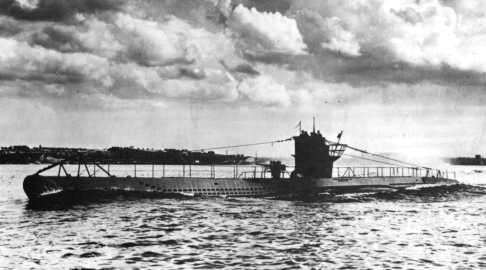Name U-100 Yard number 594 Commissioned 30 May 1940 Construction started 22 May 1939 Beam 6.2 m | Ordered 15 December 1937 Laid down 22 May 1939 Length 66 m Launched 10 April 1940 Draft 4.74 m | |
 | ||
Fate Sunk 17 March 1941 by British warships Builder Friedrich Krupp Germaniawerft Part of Kriegsmarine, 7th U-boat Flotilla | ||
German submarine U-100 was a Type VIIB U-boat of Nazi Germany's Kriegsmarine during World War II. She, given her short-lived existence, was one of the most successful and deadly U-Boats to have served in the conflict.
Contents
Design
German Type VIIB submarines were preceded by the shorter Type VIIA submarines. U-100 had a displacement of 753 tonnes (741 long tons) when at the surface and 857 tonnes (843 long tons) while submerged. She had a total length of 66.50 m (218 ft 2 in), a pressure hull length of 48.80 m (160 ft 1 in), a beam of 6.20 m (20 ft 4 in), a height of 9.50 m (31 ft 2 in), and a draught of 4.74 m (15 ft 7 in). The submarine was powered by two Germaniawerft F46 four-stroke, six-cylinder supercharged diesel engines producing a total of 2,800 to 3,200 metric horsepower (2,060 to 2,350 kW; 2,760 to 3,160 shp) for use while surfaced, two BBC GG UB 720/8 double-acting electric motors producing a total of 750 metric horsepower (550 kW; 740 shp) for use while submerged. She had two shafts and two 1.23 m (4 ft) propellers. The boat was capable of operating at depths of up to 230 metres (750 ft).
The submarine had a maximum surface speed of 17.9 knots (33.2 km/h; 20.6 mph) and a maximum submerged speed of 8 knots (15 km/h; 9.2 mph). When submerged, the boat could operate for 90 nautical miles (170 km; 100 mi) at 4 knots (7.4 km/h; 4.6 mph); when surfaced, she could travel 8,700 nautical miles (16,100 km; 10,000 mi) at 10 knots (19 km/h; 12 mph). U-100 was fitted with five 53.3 cm (21 in) torpedo tubes (four fitted at the bow and one at the stern), fourteen torpedoes, one 8.8 cm (3.46 in) SK C/35 naval gun, 220 rounds, and one 2 cm (0.79 in) anti-aircraft gun The boat had a complement of between forty-four and sixty.
First patrol
The boat was launched on 10 April 1940, with a crew of 53, under the command of Kapitänleutnant Joachim Schepke. On her first active patrol, U-100 came into contact with two Allied convoys, OA-198 and OA-204. She shadowed both convoys.
Second patrol
U-100 departed for her second active patrol on 11 September 1940, coming into contact with the Allied convoy HX 72.
Third patrol
After resupplying, U-100 departed for her third active patrol on 12 October 1940. She came into contact with two Allied convoys, HX-79 and SC-7.
Fourth patrol
U-100 departed on her fourth patrol on 7 November 1940. On 22 November she came into contact with the Allied convoy SC-11 and began to shadow it.
Fifth patrol
U-100 left for her fifth active patrol on 2 December 1940, sinking two vessels from Convoy OB 256, then a third solo vessel.
Sixth and final patrol
U-100 departed on her sixth and what would be her final patrol on 9 March 1941. She approached convoy HX 112 from astern in the pre-dawn hours of 17 March, but was detected at a range of 1,000 meters by the Type 286 radar aboard HMS Vanoc. U-100 was the first U-boat to be so discovered during World War II; she was rammed and sunk by Vanoc while attempting to submerge. Another destroyer, HMS Walker, was also present. Six of the boat's 53 crew members survived, spending the remainder of the war as POWs. Schepke was not one of them.
